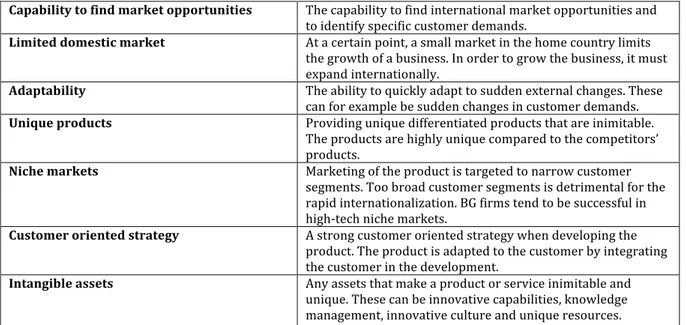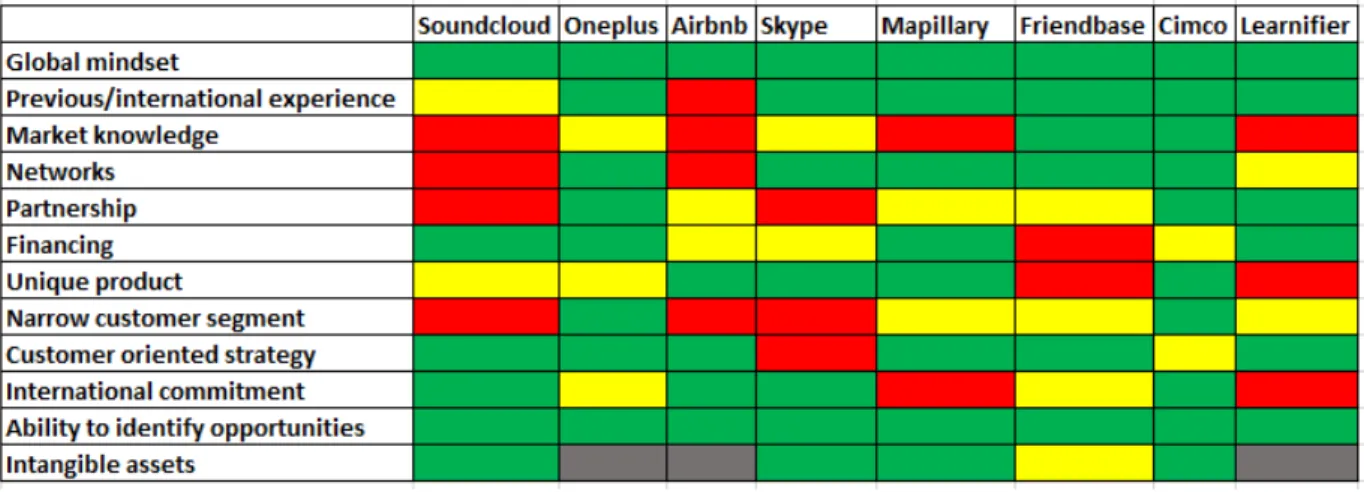B
ORN
G
LOBAL
(BG)
–
T
HE COMPARISON OF SUCCESS FACTORS
BETWEEN DIGITAL AND MANUFACTURING FIRMS
.
Thomas Bergsten & Alexander Gertzell Lunds University, Faculty of Engineering (LTH)
__________________________________________________________________________________
New digital technologies have had a large impact on the rise of BG firms. Companies can now without large amount of funding’s or experience reach out and distribute their services online to virtually the whole world overnight. Today most literature and research of BGs is based on high-‐‑tech manufacturing companies and a knowledge gap exists for the literature about digital BGs.
Born Global
BG firms are organizations that seek to use resources and have sales performance in multiple countries at an early stage as a strategy to gain competitive advantage. The term early stage often refers to within two to four years after the birth of a company. A more quantitative definition is that BGs start to export within two years of inception and that the exports are at least a quarter of the total sales.
Many BG companies are in the high-‐‑tech industry and outlined by small manufacturing companies that has developed a significant breakthrough in a technology or process, either by unique ideas or new business approaches. However, there are many examples of BG companies that are not high-‐‑tech and produce standardized products in very specialized niche markets within mature markets.
Success factors
The literature study showed several success factors that were needed to be obtained for manufacturing BGs to become successful.
Success factor Definition
Previous experience Any industry or international experience. This can be acquired from working abroad, working in the relevant industry, working with international marketing or life experience abroad.
Market knowledge Any knowledge of the targeted markets that can be used in the internationalization.
Networks Any personal or business networks that can be exploited. These can stem from the previously mentioned international
experience.
Global vision The desire to expand and compete globally. The business is not bound to certain markets. The whole world is seen as a market. Commitment to internationalization The commitment to internationalize and to overcome any
Capability to find market opportunities The capability to find international market opportunities and to identify specific customer demands.
Limited domestic market At a certain point, a small market in the home country limits the growth of a business. In order to grow the business, it must expand internationally.
Adaptability The ability to quickly adapt to sudden external changes. These can for example be sudden changes in customer demands. Unique products Providing unique differentiated products that are inimitable.
The products are highly unique compared to the competitors’ products.
Niche markets Marketing of the product is targeted to narrow customer segments. Too broad customer segments is detrimental for the rapid internationalization. BG firms tend to be successful in high-‐‑tech niche markets.
Customer oriented strategy A strong customer oriented strategy when developing the product. The product is adapted to the customer by integrating the customer in the development.
Intangible assets Any assets that make a product or service inimitable and unique. These can be innovative capabilities, knowledge management, innovative culture and unique resources.
Table 1 – Success factors of Born Globals according to the literature study
These success factors were tested in a survey and in a case study with 8 different companies, 4 unicorn companies and 4 SME companies.
Unicorn company:
A start-‐‑up company backed by venture capital that are valued at over one billion dollars. These were examples of extremely successful BGs.
Small multinational enterprise (SME) A company with less than 250 employees and with a yearly turnover up to a maximum of 50 million euro. The examples used from SMEs in the case study have recently been or is in the early stages of rapid internationalization.
Table 2 – Definitions of Unicorn and SME companies
Case Study
The aim of the case study was, as mentioned previously, to gain an understanding of how digital BG companies differ from the current literature that is mainly based on manufacturing BG firms. The focus was on how these two types of firms differ regarding the success factors of rapid internationalization.
The companies were ranked and compared according to a RAG scale. The colours represent how the companies ranked in each success factor, with green meaning high, amber meaning medium and red meaning a low fulfilment of the factor. Grey represented lack of data.
Table 3 -‐‑ Case study results, ranking each case company on each success factor with red, amber, green or grey
Conclusions
The identified success factors for Born Global firms that correlated between digital and manufacturing firms were to have a global mind-‐‑set, an ability to identify specific market opportunities and a customer oriented strategy.
To have a unique product, a narrow customer segment and a commitment to internationalize did not seem as important for digital firms.
Table 4 -‐‑ Case analysis comparison between manufacturing and digital companies with red, amber, green or grey Digital firms do not necessarily need previous industry and international experience, market knowledge and networks. However, this must be obtained at a later stage.
A large user base is very important for digital firms. There is a need to capture as much of the market as possible at an early stage. For manufacturing firms, a large customer base may be detrimental to the quality of the distribution chain. A freemium business strategy can be used by digital companies to grow their user base.
Digital firms do not necessarily have to rely on partnerships to the same extent as manufacturing firms do. This is because they are not as dependent on distributors for distribution and marketing. In the early stages of internationalization, financial resources are not as important for digital firms as for manufacturing firms. Investments should rather lead to acquiring the market knowledge, networks and experience that they may lack. Therefore, sources like crowdfunding is not an ideal source of investment.
New ground-‐‑breaking innovations open up for new types of products. With innovations like the smartphone, countless of new types of companies and products emerge. At this time, this seems to be most beneficial for the digital companies.
For manufacturing firms, e-‐‑commerce has provided a way to reach a global market and to reduce costs. This may also lead to manufacturing firms shifting towards resembling digital firms in the future.
Future research
Since the BG area in general is so unexplored, there are many ways to continue this research. Differences among digital firms can be investigated. Other categories can be explored such as service companies, consulting firms, among others. There are potential differences between BG firms depending on the time that they were founded. Other phases in the company life cycle can also be explored, by for example looking at mature BG firms. There may also be differences between BG firms and Born again globals.
What has been shown in this project is that there are differences between digital and
manufacturing BG firms, regarding success factors. However, exactly what those differences are have not been thoroughly investigated. Future research may include a larger number of case companies in order to further outline exactly what factors differ between the two.

